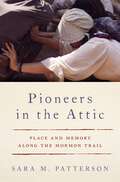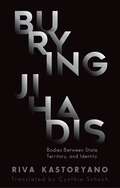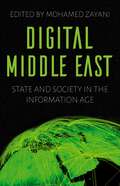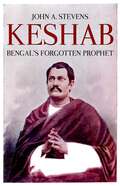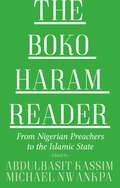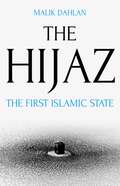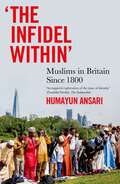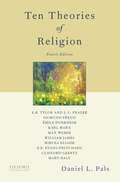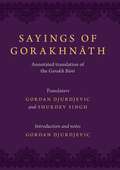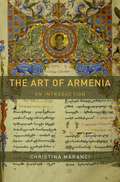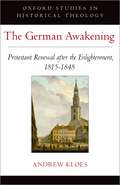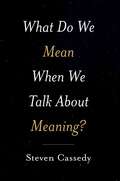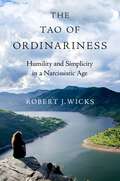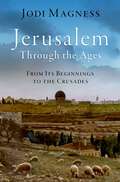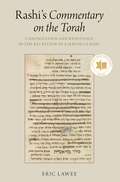- Table View
- List View
Pioneers in the Attic
by Sara M. PattersonWhy do thousands of Mormons devote their summer vacations to following the Mormon Trail? Why does the Church of Jesus Christ of Latter-day Day Saints spend millions of dollars to build monuments and Visitor Centers that believers can visit to experience the history of their nineteenth-century predecessors who fled westward in search of their promised land? Why do so many Mormon teenagers dress up in Little-House-on-the-Prairie-style garb and push handcarts over the highest local hills they can find? And what exactly is a "traveling Zion"? In Pioneers in the Attic, Sara Patterson analyzes how and why Mormons are engaging their nineteenth-century past in the modern era, arguing that as the LDS community globalized in the late twentieth and early twenty-first centuries, its relationship to space was transformed. Following their exodus to Utah, nineteenth-century Mormons believed that they must gather together in Salt Lake Zion - their new center place. They believed that Zion was a place you could point to on a map, a place you should dwell in to live a righteous life. Later Mormons had to reinterpret these central theological principles as their community spread around the globe, but to say that they simply spiritualized concepts that had once been understood literally is only one piece of the puzzle. Contemporary Mormons still want to touch and to feel these principles, so they mark and claim the landscapes of the American West with versions of their history carved in stone. They develop rituals that allow them not only to learn the history of the nineteenth-century journey west, but to engage it with all of their senses. Pioneers in the Attic reveals how modern-day Mormons have created a sense of community and felt religion through the memorialization of early Mormon pioneers of the American West, immortalizing a narrative of shared identity through an emphasis on place and collective memory.
Burying Jihadis: Bodies Between State, Territory, and Identity
by Riva KastoryanoWhat should states do with the bodies of suicide bombers and other jihadists who die while perpetrating terrorist attacks? This original and unsettling book explores the host of ethical and political questions raised by this dilemma, from (non-)legitimization of the 'enemy' and their cause to the non-territorial identity of individuals who identified in life with a global community of believers. Because states do not recognize suicide bombers as enemy combatants, governments must decide individually what to do with their remains. Riva Kastoryano offers a window onto this challenging predicament through the responses of the American, Spanish, British and French governments after the Al-Qaeda suicide attacks in New York, Madrid and London, and Islamic State's attacks on Paris in 2015. Interviewing officials, religious and local leaders and jihadists' families, both in their countries of origin and in the target nations, she has traced the terrorists' travel history, discovering unexpected connections between their itineraries and the handling of their burials. This fascinating book reveals how states' approaches to a seemingly practical issue are closely shaped by territory, culture, globalization and identity.
Digital Middle East: State and Society in the Information Age
In recent years, the Middle East's information and communications landscape has changed dramatically. Increasingly, states, businesses, and citizens are capitalizing on the opportunities offered by new information technologies, the fast pace of digitization, and enhanced connectivity. These changes are far from turning Middle Eastern nations into network societies, but their impact is significant. The growing adoption of a wide variety of information technologies and new media platforms in everyday life has given rise to complex dynamics that beg for a better understanding. Digital Middle East sheds a critical light on continuing changes that are closely intertwined with the adoption of information and communication technologies in the region. Drawing on case studies from throughout the Middle East, the contributors explore how these digital transformations are playing out in the social, cultural, political, and economic spheres, exposing the various disjunctions and discordances that have marked the advent of the digital Middle East.
Keshab: Bengal's Forgotten Prophet
by John StevensKeshab Chandra Sen (1838-84) was one of the most powerful and controversial figures in nineteenth-century Bengal. A religious leader and social reformer, his universalist interpretation of Hinduism found mass appeal in India, and generated considerable interest in Britain. His ideas on British imperial rule, religion and spirituality, global history, universalism and modernity were all influential, and his visit to England made him a celebrity. Many Britons regarded him as a prophet of world-historical significance. Keshab was the subject of extreme adulation and vehement criticism. Accounts tell of large crowds prostrating themselves before him, believing him to be an avatar. Yet he died with relatively few followers, his reputation in both India and Britain largely ruined. As a representative of India, Keshab became emblematic of broad concerns regarding Hinduism and Christianity, science and faith, India and the British Empire. This innovative study explores the transnational historical forces that shaped Keshab's life and work. It offers an alternative religious history of empire, characterized by intercultural dialogue and religious syncretism. A fascinating and often tragic portrait of Keshab's experience of the imperial world, and the ways in which he carried meaning for his contemporaries.
The Boko Haram Reader: From Nigerian Preachers to the Islamic State
Since it erupted onto the world stage in 2009, people have asked, what is Boko Haram, and what does it stand for? Is there a coherent vision or set of beliefs behind it? Despite the growing literature about the group, few if any attempts have been made to answer these questions, even though Boko Haram is but the latest in a long line of millenarian Muslim reform groups to emerge in Northern Nigeria over the last two centuries. The Boko Haram Reader offers an unprecedented collection of essential texts, documents, videos, audio, and nashids (martial hymns), translated into English from Hausa, Arabic and Kanuri, tracing the group's origins, history, and evolution. Its editors, two Nigerian scholars, reveal how Boko Haram's leaders manipulate Islamic theology for the legitimisation, radicalization, indoctrination and dissemination of their ideas across West Africa. Mandatory reading for anyone wishing to grasp the underpinnings of Boko Haram's insurgency, particularly how the group strives to delegitimize its rivals and establish its beliefs as a dominant strand of Islamic thought in West Africa's religious marketplace.
The Hijaz: The First Islamic State
by Malik DahlanDahlan offers an alternative vision of Islamic governance through the history and promise of the Hijaz, the first state of Islam. The Hijaz, in the west of present-day Saudi Arabia, was the first Islamic state in Mecca and Medina. This new interpretative history offers a fresh vision of Islamic governance and law as a positive force for political reform in the Middle East and beyond. Applying key Islamic principles of public good to contemporary life, Malik Dahlan challenges two dominant narratives. He reclaims the development of Islamic statecraft as the wellspring of collective identity and statesmanship in the Arab world, simultaneously influenced and disrupted by Westphalian statehood models and Enlightenment notions of self-determination. He equally rejects the appropriation of Islamic governance and the Caliphate concept by both the post-modern, non-territorial Al-Qaeda and the neo-medievalist ISIS. Celebrating the history and untapped potential of a region where Arab leaders built the ideological foundations of an emerging polity, The Hijaz is a compelling alternative analysis of governance in the Arabian Peninsula and the global Islamic community, and of its interaction with the wider world.
"The Infidel Within": Muslims in Britain since 1800
by Humayun AnsariMuslims constitute Britain's second largest religious grouping, and writing about their experiences has found a new audience in recent years-though not always through a positive lens. But a proper historical treatment of their arrival, settlement and establishment had been conspicuously absent until Humayun Ansari's seminal work, reissued here in an updated edition. "The Infidel Within" draws together rich archival research and first-hand experience into a broad, integrated history of the Muslim presence in Britain. Among the topics addressed are migration and settlement in Britain before 1945, the evolution of a British Muslim identity, Muslim women and families, Muslims and education, and the growing mobilization of Muslims in Britain's political, religious and economic life. This definitive and sympathetic history, brought right up to date, is a must-read for anyone seeking to understand modern Britain.
Burying Jihadis: Bodies Between State, Territory, and Identity
by Riva KastoryanoWhat should states do with the bodies of suicide bombers and other jihadists who die while perpetrating terrorist attacks? This original and unsettling book explores the host of ethical and political questions raised by this dilemma, from (non-)legitimization of the 'enemy' and their cause to the non-territorial identity of individuals who identified in life with a global community of believers. Because states do not recognize suicide bombers as enemy combatants, governments must decide individually what to do with their remains. Riva Kastoryano offers a window onto this challenging predicament through the responses of the American, Spanish, British and French governments after the Al-Qaeda suicide attacks in New York, Madrid and London, and Islamic State's attacks on Paris in 2015. Interviewing officials, religious and local leaders and jihadists' families, both in their countries of origin and in the target nations, she has traced the terrorists' travel history, discovering unexpected connections between their itineraries and the handling of their burials. This fascinating book reveals how states' approaches to a seemingly practical issue are closely shaped by territory, culture, globalization and identity.
Digital Middle East: State and Society in the Information Age
by Mohamed ZayaniIn recent years, the Middle East's information and communications landscape has changed dramatically. Increasingly, states, businesses, and citizens are capitalizing on the opportunities offered by new information technologies, the fast pace of digitization, and enhanced connectivity. These changes are far from turning Middle Eastern nations into network societies, but their impact is significant. The growing adoption of a wide variety of information technologies and new media platforms in everyday life has given rise to complex dynamics that beg for a better understanding. Digital Middle East sheds a critical light on continuing changes that are closely intertwined with the adoption of information and communication technologies in the region. Drawing on case studies from throughout the Middle East, the contributors explore how these digital transformations are playing out in the social, cultural, political, and economic spheres, exposing the various disjunctions and discordances that have marked the advent of the digital Middle East.
Keshab: Bengal's Forgotten Prophet
by John StevensKeshab Chandra Sen (1838-84) was one of the most powerful and controversial figures in nineteenth-century Bengal. A religious leader and social reformer, his universalist interpretation of Hinduism found mass appeal in India, and generated considerable interest in Britain. His ideas on British imperial rule, religion and spirituality, global history, universalism and modernity were all influential, and his visit to England made him a celebrity. Many Britons regarded him as a prophet of world-historical significance. Keshab was the subject of extreme adulation and vehement criticism. Accounts tell of large crowds prostrating themselves before him, believing him to be an avatar. Yet he died with relatively few followers, his reputation in both India and Britain largely ruined. As a representative of India, Keshab became emblematic of broad concerns regarding Hinduism and Christianity, science and faith, India and the British Empire. This innovative study explores the transnational historical forces that shaped Keshab's life and work. It offers an alternative religious history of empire, characterized by intercultural dialogue and religious syncretism. A fascinating and often tragic portrait of Keshab's experience of the imperial world, and the ways in which he carried meaning for his contemporaries.
The Boko Haram Reader: From Nigerian Preachers to the Islamic State
by Abdulbasit Kassim and Michael NwankpaSince it erupted onto the world stage in 2009, people have asked, what is Boko Haram, and what does it stand for? Is there a coherent vision or set of beliefs behind it? Despite the growing literature about the group, few if any attempts have been made to answer these questions, even though Boko Haram is but the latest in a long line of millenarian Muslim reform groups to emerge in Northern Nigeria over the last two centuries. The Boko Haram Reader offers an unprecedented collection of essential texts, documents, videos, audio, and nashids (martial hymns), translated into English from Hausa, Arabic and Kanuri, tracing the group's origins, history, and evolution. Its editors, two Nigerian scholars, reveal how Boko Haram's leaders manipulate Islamic theology for the legitimisation, radicalization, indoctrination and dissemination of their ideas across West Africa. Mandatory reading for anyone wishing to grasp the underpinnings of Boko Haram's insurgency, particularly how the group strives to delegitimize its rivals and establish its beliefs as a dominant strand of Islamic thought in West Africa's religious marketplace.
The Hijaz: The First Islamic State
by Malik DahlanDahlan offers an alternative vision of Islamic governance through the history and promise of the Hijaz, the first state of Islam. The Hijaz, in the west of present-day Saudi Arabia, was the first Islamic state in Mecca and Medina. This new interpretative history offers a fresh vision of Islamic governance and law as a positive force for political reform in the Middle East and beyond. Applying key Islamic principles of public good to contemporary life, Malik Dahlan challenges two dominant narratives. He reclaims the development of Islamic statecraft as the wellspring of collective identity and statesmanship in the Arab world, simultaneously influenced and disrupted by Westphalian statehood models and Enlightenment notions of self-determination. He equally rejects the appropriation of Islamic governance and the Caliphate concept by both the post-modern, non-territorial Al-Qaeda and the neo-medievalist ISIS. Celebrating the history and untapped potential of a region where Arab leaders built the ideological foundations of an emerging polity, The Hijaz is a compelling alternative analysis of governance in the Arabian Peninsula and the global Islamic community, and of its interaction with the wider world.
"The Infidel Within": Muslims in Britain since 1800
by Humayun AnsariMuslims constitute Britain's second largest religious grouping, and writing about their experiences has found a new audience in recent years-though not always through a positive lens. But a proper historical treatment of their arrival, settlement and establishment had been conspicuously absent until Humayun Ansari's seminal work, reissued here in an updated edition. "The Infidel Within" draws together rich archival research and first-hand experience into a broad, integrated history of the Muslim presence in Britain. Among the topics addressed are migration and settlement in Britain before 1945, the evolution of a British Muslim identity, Muslim women and families, Muslims and education, and the growing mobilization of Muslims in Britain's political, religious and economic life. This definitive and sympathetic history, brought right up to date, is a must-read for anyone seeking to understand modern Britain.
Ten Theories of Religion
by Daniel PalsWhy do human beings believe in divinities? Why do some seek eternal life, while others seek escape from recurring lives? Why do the beliefs and behaviors we typically call "religious" so deeply affect the human personality and so subtly weave their way through human society? Ideal as a supplementary text in introductory religion courses or as the main text in theory and method in religious studies or in sociology of religion courses, Ten Theories of Religion, Fourth Edition, offers an illuminating treatment of this controversial and fascinating subject.
Sayings of Gorakhnath: Annotated Translation of the Gorakh Bani
by Gordan DjurdjevicSayings of Gorakhnath presents a translation of late-medieval texts in Old Hindi, traditionally attributed to one of the founders of the Order of Nath Yogis. The Naths are associated with the creation and development of hatha yoga, with important historical and ideological links to Hindu tantra and alchemy. The texts gathered in this collection on the one hand provide a criticism of religious authority based on external knowledge lacking personal experience, while on the other hand they celebrate the path of yoga and its methods of engagement with the subtle body and its centres of occult energy and miraculous powers. The ultimate goal of the style of yoga described in the Sayings of Gorakhnath concerns the attainment of immortality and divinization of its adepts. This is achieved by redirecting the trajectory of the seminal fluid, which in the process transforms into the elixir, the amrt. In order to accomplish that goal, a regime of yogic practices is suggested, consisting of the assumption of a steady posture, breathing exercises, mantra chanting, and meditation. Djudjevic and Singh's translations are preceded by an introduction and accompanied by notes, which contextualize and elucidate the subject matter.
The Art of Armenia: An Introduction
by Christina MaranciThough immediately recognizable in public discourse as a modern state in a political "hot zone," Armenia has a material history and visual culture that reaches back to the Paleolithic era. This book presents a timely and much-needed survey of the arts of Armenia from antiquity to the early eighteenth century C.E. Divided chronologically, it brings into discussion a wide range of media, including architecture, stone sculpture, works in metal, wood, and cloth, manuscript illumination, and ceramic arts. Critically, The Art of Armenia presents this material within historical and archaeological contexts, incorporating the results of specialist literature in various languages. It also positions Armenian art within a range of broader comparative contexts including, but not limited to, the ancient Mediterranean and Near East, Byzantium, the Islamic world, Yuan-dynasty China, and seventeenth-century Europe. The Art of Armenia offers students, scholars, and heritage readers of the Armenian community something long desired but never before available: a complete and authoritative introduction to three thousand years of Armenian art, archaeology, architecture, and design.
The German Awakening: Protestant Renewal after the Enlightenment, 1815-1848 (Oxford Studies in Historical Theology)
by Andrew KloesHistorians of modern German culture and church history refer to "the Awakening movement" (die Erweckungsbewegung) to describe a period in the history of German Protestantism between the end of the Napoleonic Wars in 1815 and the Revolution of 1848. "The Awakening" was the last major nationwide Protestant reform and revival movement to occur in Germany. This book analyzes numerous primary sources from the era of the Awakening and synthesizes the current state of German scholarship for an English-speaking audience. It examines the Awakening as a product of the larger social changes that were re-shaping German society during the early decades of the nineteenth century. Theologically, Awakened Protestants were traditionalists. They affirmed religious doctrines that orthodox Protestants had professed since the confessional statements of the Reformation-era. Awakened Protestants rejected the changes that Enlightenment thought had introduced into Protestant theology and preaching since the mid-eighteenth century. However, Awakened Protestants were also themselves distinctly modern. Their efforts to spread their religious beliefs were successful because of the new political freedoms and economic opportunities that the Enlightenment had introduced. These social conditions gave German Protestants new means and abilities to pursue their religious goals. Awakened Protestants were leaders in the German churches and in the universities. They used their influence to found many voluntary organizations for evangelism, in Germany and abroad. They also established many institutions to ameliorate the living conditions of those in poverty. Adapting Protestantism to modern society in these ways was the most original and innovative aspect of the Awakening movement.
The German Awakening: Protestant Renewal after the Enlightenment, 1815-1848 (Oxford Studies in Historical Theology)
by Andrew KloesHistorians of modern German culture and church history refer to "the Awakening movement" (die Erweckungsbewegung) to describe a period in the history of German Protestantism between the end of the Napoleonic Wars in 1815 and the Revolution of 1848. "The Awakening" was the last major nationwide Protestant reform and revival movement to occur in Germany. This book analyzes numerous primary sources from the era of the Awakening and synthesizes the current state of German scholarship for an English-speaking audience. It examines the Awakening as a product of the larger social changes that were re-shaping German society during the early decades of the nineteenth century. Theologically, Awakened Protestants were traditionalists. They affirmed religious doctrines that orthodox Protestants had professed since the confessional statements of the Reformation-era. Awakened Protestants rejected the changes that Enlightenment thought had introduced into Protestant theology and preaching since the mid-eighteenth century. However, Awakened Protestants were also themselves distinctly modern. Their efforts to spread their religious beliefs were successful because of the new political freedoms and economic opportunities that the Enlightenment had introduced. These social conditions gave German Protestants new means and abilities to pursue their religious goals. Awakened Protestants were leaders in the German churches and in the universities. They used their influence to found many voluntary organizations for evangelism, in Germany and abroad. They also established many institutions to ameliorate the living conditions of those in poverty. Adapting Protestantism to modern society in these ways was the most original and innovative aspect of the Awakening movement.
What Do We Mean When We Talk about Meaning?
by Steven CassedyA comprehensive journey through the history of "meaning," from antiquity to modern day. The word meaning appears often in our daily lives: religious leaders holding out the promise of meaning for their followers, self-help manuals seeking to demonstrate the power of meaning to enrich our lives, and most frequently people questioning the meaning of life. The word carries a multitude of connotations, from "purpose" to "value" and "essence" to "mysterious truth", but this diversity of understanding is rarely explored. In What Do We Mean When We Talk About Meaning?, Steven Cassedy tells the story of how a word that began by denoting "signifying" and "intending" came to acquire such a broad array of sub-definitions. The book begins with the early Christian thinkers who believed meaning could be "read" from the world as if it were holy scripture, then moves into the philosophers who adapted this notion and eventually the Romantic-era Germans that coined "the meaning of life," a phrase that later traveled to Great Britain, the United States, and Russia. The book also extends into the twentieth century, when "meaning" acquired its greatest power in the realms of religion, psychotherapy, and self-help, all of which helped it to accumulate the fluidity and ambiguity it still displays today.
What Do We Mean When We Talk about Meaning?
by Steven CassedyA comprehensive journey through the history of "meaning," from antiquity to modern day. The word meaning appears often in our daily lives: religious leaders holding out the promise of meaning for their followers, self-help manuals seeking to demonstrate the power of meaning to enrich our lives, and most frequently people questioning the meaning of life. The word carries a multitude of connotations, from "purpose" to "value" and "essence" to "mysterious truth", but this diversity of understanding is rarely explored. In What Do We Mean When We Talk About Meaning?, Steven Cassedy tells the story of how a word that began by denoting "signifying" and "intending" came to acquire such a broad array of sub-definitions. The book begins with the early Christian thinkers who believed meaning could be "read" from the world as if it were holy scripture, then moves into the philosophers who adapted this notion and eventually the Romantic-era Germans that coined "the meaning of life," a phrase that later traveled to Great Britain, the United States, and Russia. The book also extends into the twentieth century, when "meaning" acquired its greatest power in the realms of religion, psychotherapy, and self-help, all of which helped it to accumulate the fluidity and ambiguity it still displays today.
The Tao of Ordinariness: Humility and Simplicity in a Narcissistic Age
by Robert J. WicksThis book is an invitation to come home to your authentic self in a world that is frequently mesmerized by "spin," narcissism, fantasy, and exhibitionism. Psychology and classic wisdom literature have, in various ways, long recognized the value for simply becoming who you are (i.e., ordinariness). However, this call is becoming increasingly drowned out by the many other voices that emphasize publicity and image-making over authenticity and humility. Renowned therapist and author Robert Wicks has written The Tao of Ordinariness as a way of beginning to address these tendencies in contemporary society. In this new countercultural work, the strength and joy of exploring who you are - and proceeding to share yourself with others in a way that they too can reclaim themselves - is revisited from a range of vantage points. The author specifically reexamines themes of humility, simplicity, letting go, self-awareness, "alonetime," resilience, and mentoring. In an era when people increasingly measure self-worth by external measures, such as the number of likes and views and followers on social media feeds (which have many individuals chasing impossible fantasies and living with a constant fear of "missing out"), Wicks offers a return to your authentic self.
The Tao of Ordinariness: Humility and Simplicity in a Narcissistic Age
by Robert J. WicksThis book is an invitation to come home to your authentic self in a world that is frequently mesmerized by "spin," narcissism, fantasy, and exhibitionism. Psychology and classic wisdom literature have, in various ways, long recognized the value for simply becoming who you are (i.e., ordinariness). However, this call is becoming increasingly drowned out by the many other voices that emphasize publicity and image-making over authenticity and humility. Renowned therapist and author Robert Wicks has written The Tao of Ordinariness as a way of beginning to address these tendencies in contemporary society. In this new countercultural work, the strength and joy of exploring who you are - and proceeding to share yourself with others in a way that they too can reclaim themselves - is revisited from a range of vantage points. The author specifically reexamines themes of humility, simplicity, letting go, self-awareness, "alonetime," resilience, and mentoring. In an era when people increasingly measure self-worth by external measures, such as the number of likes and views and followers on social media feeds (which have many individuals chasing impossible fantasies and living with a constant fear of "missing out"), Wicks offers a return to your authentic self.
Jerusalem through the Ages: From Its Beginnings to the Crusades
by Jodi MagnessA major new history of one of the world's holiest of cities, based on the most recent archaeological discoveries First settled five thousand years ago by a mountain spring between the Mediterranean and Dead Sea, Jerusalem was named for the god (Shalem) that was worshipped there. When David reportedly conquered the city, ca. 1000 BCE, he transferred the Ark of the Covenant--and with it, the presence of the God of Israel--to this rocky outcrop. Here, David's son Solomon built a permanent house for the God of Israel called the first temple, and since then this spot has been known as the Temple Mount. After Babylonians destroyed Solomon's temple in 586 BCE, it was replaced by the second temple, which is the setting for many of the events described in the Gospel accounts. In 70 CE, the Romans destroyed Jerusalem, leaving the Temple Mount in ruins. Two hundred and fifty years later, the emperor Constantine constructed the Church of the Holy Sepulcher around the spots where Jesus is believed to have been crucified and buried, and the church is now considered Jerusalem's holiest site by many Christians worldwide. In the late seventh century CE the focus shifted back to the Temple Mount, when an early Islamic ruler named `Abd al-Malek enshrined the rocky outcrop in a monument that is still iconic of the city today: the Dome of the Rock. In 1099 Crusaders conquered Jerusalem, and although their rule was brief rule they left a deep impact on the city. Today, much of the old city retains its medieval appearance. For followers of the three Abrahamic faiths, Jerusalem is the place where the presence of the God of Israel dwells--the meeting point of heaven and earth and the locus of divine and human interaction. Jerusalem through the Ages by Jodi Magness explores how these beliefs came to be associated with the city by introducing readers to its complex and layered history, providing a broad yet detailed account, including the most recent archaeological discoveries. Each chapter focuses on a key moment of transition from Jerusalem's beginnings to the Crusades of the medieval period, enabling readers to experience the city's many transformations as it changed hands and populations-Jebusites, Israelites, Judahites, Persians, Greeks, Romans, Jews, Christians, and Muslims. The book also includes a walking guide for visitors who wish to experience the city's many archaeological sites firsthand.
Jerusalem through the Ages: From Its Beginnings to the Crusades
by Jodi MagnessA major new history of one of the world's holiest of cities, based on the most recent archaeological discoveries First settled five thousand years ago by a mountain spring between the Mediterranean and Dead Sea, Jerusalem was named for the god (Shalem) that was worshipped there. When David reportedly conquered the city, ca. 1000 BCE, he transferred the Ark of the Covenant--and with it, the presence of the God of Israel--to this rocky outcrop. Here, David's son Solomon built a permanent house for the God of Israel called the first temple, and since then this spot has been known as the Temple Mount. After Babylonians destroyed Solomon's temple in 586 BCE, it was replaced by the second temple, which is the setting for many of the events described in the Gospel accounts. In 70 CE, the Romans destroyed Jerusalem, leaving the Temple Mount in ruins. Two hundred and fifty years later, the emperor Constantine constructed the Church of the Holy Sepulcher around the spots where Jesus is believed to have been crucified and buried, and the church is now considered Jerusalem's holiest site by many Christians worldwide. In the late seventh century CE the focus shifted back to the Temple Mount, when an early Islamic ruler named `Abd al-Malek enshrined the rocky outcrop in a monument that is still iconic of the city today: the Dome of the Rock. In 1099 Crusaders conquered Jerusalem, and although their rule was brief rule they left a deep impact on the city. Today, much of the old city retains its medieval appearance. For followers of the three Abrahamic faiths, Jerusalem is the place where the presence of the God of Israel dwells--the meeting point of heaven and earth and the locus of divine and human interaction. Jerusalem through the Ages by Jodi Magness explores how these beliefs came to be associated with the city by introducing readers to its complex and layered history, providing a broad yet detailed account, including the most recent archaeological discoveries. Each chapter focuses on a key moment of transition from Jerusalem's beginnings to the Crusades of the medieval period, enabling readers to experience the city's many transformations as it changed hands and populations-Jebusites, Israelites, Judahites, Persians, Greeks, Romans, Jews, Christians, and Muslims. The book also includes a walking guide for visitors who wish to experience the city's many archaeological sites firsthand.
Rashi's Commentary on the Torah: Canonization and Resistance in the Reception of a Jewish Classic
by Eric LaweeWinner of the Jewish Book Council Nahum M. Sarna Memorial Award in Scholarship This book explores the reception history of the most important Jewish Bible commentary ever composed, the Commentary on the Torah of Rashi (Shlomo Yitzhaki; 1040-1105). Though the Commentary has benefited from enormous scholarly attention, analysis of diverse reactions to it has been surprisingly scant. Viewing its path to preeminence through a diverse array of religious, intellectual, literary, and sociocultural lenses, Eric Lawee focuses on processes of the Commentary's canonization and on a hitherto unexamined--and wholly unexpected--feature of its reception: critical, and at times astonishingly harsh, resistance to it. Lawee shows how and why, despite such resistance, Rashi's interpretation of the Torah became an exegetical classic, a staple in the curriculum, a source of shared religious vocabulary for Jews across time and place, and a foundational text that shaped the Jewish nation's collective identity. The book takes as its larger integrating perspective processes of canonicity as they shape how traditions flourish, disintegrate, or evolve. Rashi's scriptural magnum opus, the foremost work of Franco-German (Ashkenazic) biblical scholarship, faced stiff competition for canonical supremacy in the form of rationalist reconfigurations of Judaism as they developed in Mediterranean seats of learning. It nevertheless emerged triumphant in an intense battle for Judaism's future that unfolded in late medieval and early modern times. Investigation of the reception of the Commentary throws light on issues in Jewish scholarship and spirituality that continue to stir reflection, and even passionate debate, in the Jewish world today.
